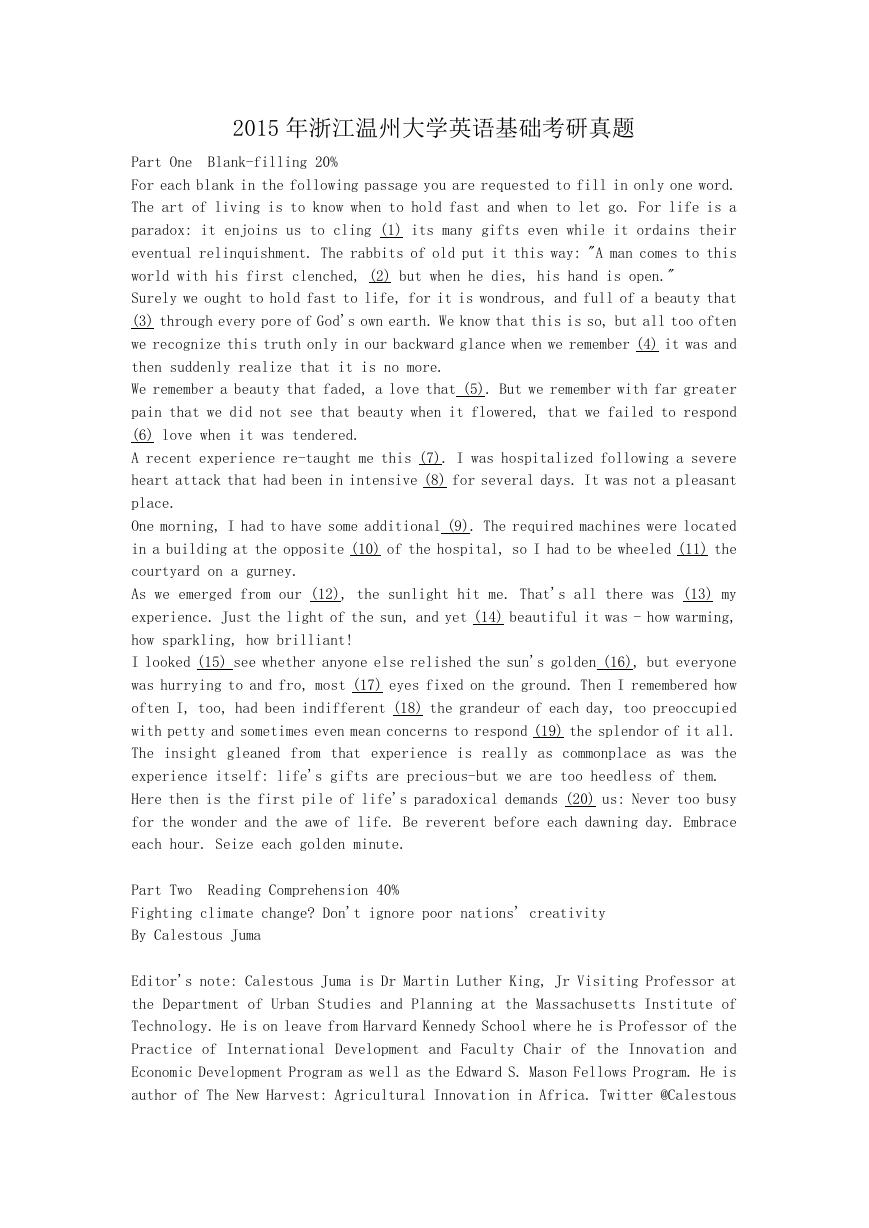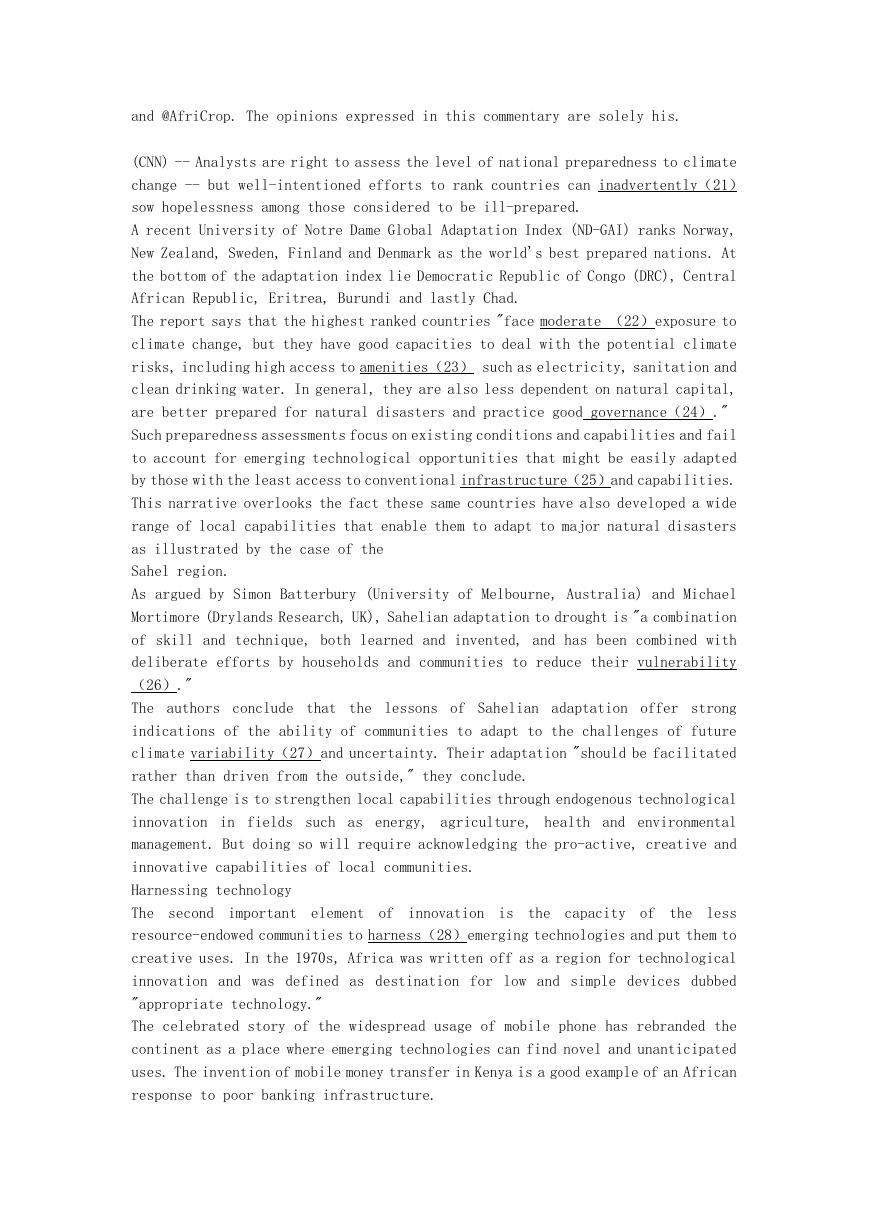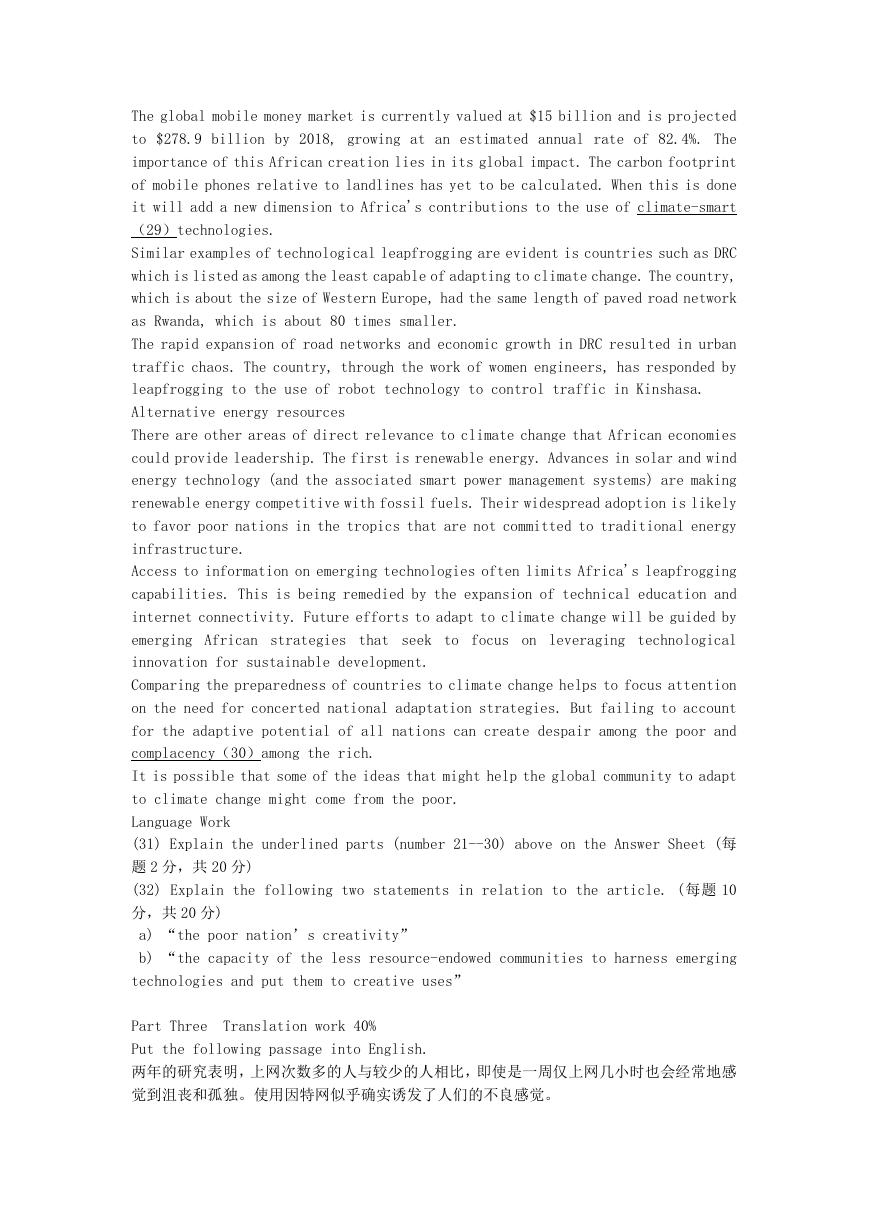2015 年浙江温州大学英语基础考研真题
Part One Blank-filling 20%
For each blank in the following passage you are requested to fill in only one word.
The art of living is to know when to hold fast and when to let go. For life is a
paradox: it enjoins us to cling (1) its many gifts even while it ordains their
eventual relinquishment. The rabbits of old put it this way: "A man comes to this
world with his first clenched, (2) but when he dies, his hand is open."
Surely we ought to hold fast to life, for it is wondrous, and full of a beauty that
(3) through every pore of God's own earth. We know that this is so, but all too often
we recognize this truth only in our backward glance when we remember (4) it was and
then suddenly realize that it is no more.
We remember a beauty that faded, a love that (5). But we remember with far greater
pain that we did not see that beauty when it flowered, that we failed to respond
(6) love when it was tendered.
A recent experience re-taught me this (7). I was hospitalized following a severe
heart attack that had been in intensive (8) for several days. It was not a pleasant
place.
One morning, I had to have some additional (9). The required machines were located
in a building at the opposite (10) of the hospital, so I had to be wheeled (11) the
courtyard on a gurney.
As we emerged from our (12), the sunlight hit me. That's all there was (13) my
experience. Just the light of the sun, and yet (14) beautiful it was - how warming,
how sparkling, how brilliant!
I looked (15) see whether anyone else relished the sun's golden (16), but everyone
was hurrying to and fro, most (17) eyes fixed on the ground. Then I remembered how
often I, too, had been indifferent (18) the grandeur of each day, too preoccupied
with petty and sometimes even mean concerns to respond (19) the splendor of it all.
The insight gleaned from that experience is really as commonplace as was the
experience itself: life's gifts are precious-but we are too heedless of them.
Here then is the first pile of life's paradoxical demands (20) us: Never too busy
for the wonder and the awe of life. Be reverent before each dawning day. Embrace
each hour. Seize each golden minute.
Part Two Reading Comprehension 40%
Fighting climate change? Don't ignore poor nations' creativity
By Calestous Juma
Editor's note: Calestous Juma is Dr Martin Luther King, Jr Visiting Professor at
the Department of Urban Studies and Planning at the Massachusetts Institute of
Technology. He is on leave from Harvard Kennedy School where he is Professor of the
Practice of International Development and Faculty Chair of the Innovation and
Economic Development Program as well as the Edward S. Mason Fellows Program. He is
author of The New Harvest: Agricultural Innovation in Africa. Twitter @Calestous
�
and @AfriCrop. The opinions expressed in this commentary are solely his.
(CNN) -- Analysts are right to assess the level of national preparedness to climate
change -- but well-intentioned efforts to rank countries can inadvertently(21)
sow hopelessness among those considered to be ill-prepared.
A recent University of Notre Dame Global Adaptation Index (ND-GAI) ranks Norway,
New Zealand, Sweden, Finland and Denmark as the world's best prepared nations. At
the bottom of the adaptation index lie Democratic Republic of Congo (DRC), Central
African Republic, Eritrea, Burundi and lastly Chad.
The report says that the highest ranked countries "face moderate (22)exposure to
climate change, but they have good capacities to deal with the potential climate
risks, including high access to amenities(23) such as electricity, sanitation and
clean drinking water. In general, they are also less dependent on natural capital,
are better prepared for natural disasters and practice good governance(24)."
Such preparedness assessments focus on existing conditions and capabilities and fail
to account for emerging technological opportunities that might be easily adapted
by those with the least access to conventional infrastructure(25)and capabilities.
This narrative overlooks the fact these same countries have also developed a wide
range of local capabilities that enable them to adapt to major natural disasters
as illustrated by the case of the
Sahel region.
As argued by Simon Batterbury (University of Melbourne, Australia) and Michael
Mortimore (Drylands Research, UK), Sahelian adaptation to drought is "a combination
of skill and technique, both learned and invented, and has been combined with
deliberate efforts by households and communities to reduce their vulnerability
(26)."
The authors conclude that the lessons of Sahelian adaptation offer strong
indications of the ability of communities to adapt to the challenges of future
climate variability(27)and uncertainty. Their adaptation "should be facilitated
rather than driven from the outside," they conclude.
The challenge is to strengthen local capabilities through endogenous technological
innovation in fields such as energy, agriculture, health and environmental
management. But doing so will require acknowledging the pro-active, creative and
innovative capabilities of local communities.
Harnessing technology
The second important element of innovation is the capacity of the less
resource-endowed communities to harness(28)emerging technologies and put them to
creative uses. In the 1970s, Africa was written off as a region for technological
innovation and was defined as destination for low and simple devices dubbed
"appropriate technology."
The celebrated story of the widespread usage of mobile phone has rebranded the
continent as a place where emerging technologies can find novel and unanticipated
uses. The invention of mobile money transfer in Kenya is a good example of an African
response to poor banking infrastructure.
�
The global mobile money market is currently valued at $15 billion and is projected
to $278.9 billion by 2018, growing at an estimated annual rate of 82.4%. The
importance of this African creation lies in its global impact. The carbon footprint
of mobile phones relative to landlines has yet to be calculated. When this is done
it will add a new dimension to Africa's contributions to the use of climate-smart
(29)technologies.
Similar examples of technological leapfrogging are evident is countries such as DRC
which is listed as among the least capable of adapting to climate change. The country,
which is about the size of Western Europe, had the same length of paved road network
as Rwanda, which is about 80 times smaller.
The rapid expansion of road networks and economic growth in DRC resulted in urban
traffic chaos. The country, through the work of women engineers, has responded by
leapfrogging to the use of robot technology to control traffic in Kinshasa.
Alternative energy resources
There are other areas of direct relevance to climate change that African economies
could provide leadership. The first is renewable energy. Advances in solar and wind
energy technology (and the associated smart power management systems) are making
renewable energy competitive with fossil fuels. Their widespread adoption is likely
to favor poor nations in the tropics that are not committed to traditional energy
infrastructure.
Access to information on emerging technologies often limits Africa's leapfrogging
capabilities. This is being remedied by the expansion of technical education and
internet connectivity. Future efforts to adapt to climate change will be guided by
emerging African strategies that seek to focus on leveraging technological
innovation for sustainable development.
Comparing the preparedness of countries to climate change helps to focus attention
on the need for concerted national adaptation strategies. But failing to account
for the adaptive potential of all nations can create despair among the poor and
complacency(30)among the rich.
It is possible that some of the ideas that might help the global community to adapt
to climate change might come from the poor.
Language Work
(31) Explain the underlined parts (number 21--30) above on the Answer Sheet (每
题 2 分,共 20 分)
(32) Explain the following two statements in relation to the article. (每题 10
分,共 20 分)
a) “the poor nation’s creativity”
b) “the capacity of the less resource-endowed communities to harness emerging
technologies and put them to creative uses”
Translation work 40%
Part Three
Put the following passage into English.
两年的研究表明,上网次数多的人与较少的人相比,即使是一周仅上网几小时也会经常地感
觉到沮丧和孤独。使用因特网似乎确实诱发了人们的不良感觉。
�
研究人员对这些结果困惑不解,因为这与他们的预料截然相反。他们预测,和看电视相比,
从社交角度来说,上网可能更健康一些,因为网络允许使用者选择自己需要的信息并且和别
人进行交流。
研究者推测说,上网使人减少了和家人及朋友共度的时光,这也许可以解释他们心理健康状
况下降的原因。和面对面的交谈相比,这种见不着面、看不见人的“虚”的交流可能会使人
从心理上缺乏满足感,人们通过这种交流结下的友谊也不会太深。还有一种可能是,
网民通过因特网所了解到的广阔世界使得他们对自己的生活不那么满意了。
Essay-writing 50%
Part Four
Topic: On Ice-bucket Challenge
Word limit: 500-600
(Please write your essay on the Answer Sheet)
�








 2023年江西萍乡中考道德与法治真题及答案.doc
2023年江西萍乡中考道德与法治真题及答案.doc 2012年重庆南川中考生物真题及答案.doc
2012年重庆南川中考生物真题及答案.doc 2013年江西师范大学地理学综合及文艺理论基础考研真题.doc
2013年江西师范大学地理学综合及文艺理论基础考研真题.doc 2020年四川甘孜小升初语文真题及答案I卷.doc
2020年四川甘孜小升初语文真题及答案I卷.doc 2020年注册岩土工程师专业基础考试真题及答案.doc
2020年注册岩土工程师专业基础考试真题及答案.doc 2023-2024学年福建省厦门市九年级上学期数学月考试题及答案.doc
2023-2024学年福建省厦门市九年级上学期数学月考试题及答案.doc 2021-2022学年辽宁省沈阳市大东区九年级上学期语文期末试题及答案.doc
2021-2022学年辽宁省沈阳市大东区九年级上学期语文期末试题及答案.doc 2022-2023学年北京东城区初三第一学期物理期末试卷及答案.doc
2022-2023学年北京东城区初三第一学期物理期末试卷及答案.doc 2018上半年江西教师资格初中地理学科知识与教学能力真题及答案.doc
2018上半年江西教师资格初中地理学科知识与教学能力真题及答案.doc 2012年河北国家公务员申论考试真题及答案-省级.doc
2012年河北国家公务员申论考试真题及答案-省级.doc 2020-2021学年江苏省扬州市江都区邵樊片九年级上学期数学第一次质量检测试题及答案.doc
2020-2021学年江苏省扬州市江都区邵樊片九年级上学期数学第一次质量检测试题及答案.doc 2022下半年黑龙江教师资格证中学综合素质真题及答案.doc
2022下半年黑龙江教师资格证中学综合素质真题及答案.doc